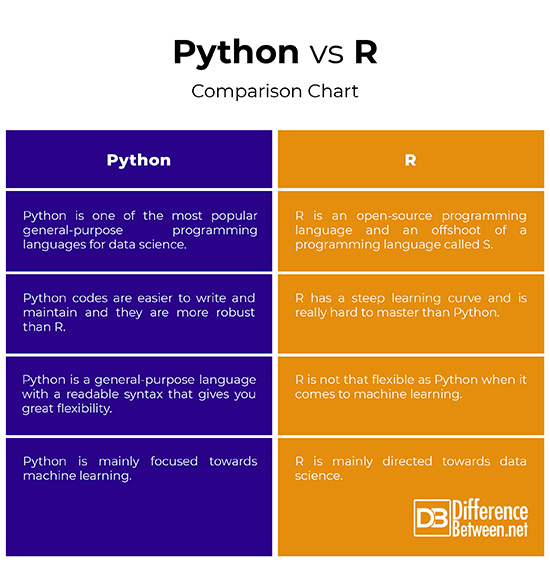Difference Between Python and R Machine Learning
Machine learning is all about extracting knowledge from data and its application, in recent years, has become ubiquitous in everyday life. Machine learning techniques are being adopted for a variety of applications. From movie recommendations to what food to order or what products to buy, to recognizing your friends in pictures, many websites and applications have machine learning algorithms at their core. Look at any complex website like Amazon, Facebook, or Netflix, you’re very likely to find every part of site containing multiple machine learning models. Python has become the de facto standard for many data science applications which combines the power of general-purpose programming languages with the versatility of domain-specific scripting languages like R. However, R is not very fast and the code is poorly written and slow except it comprises of really good statistical libraries compared to Python. So should you use Python or R for machine learning?
What is Python?
Python is one of the most popular general-purpose programming languages for data science in widespread use. So it enjoys a large number of useful add-on libraries developed by its great community. Python combines the power of general-purpose programming languages with the ease-of-use of domain-specific scripting languages like R or MATLAB. It has libraries for visualization, data loading, statistics, natural language processing, image processing, and more. It provides data scientists with a large array of general and special purpose functionality. Over the years, Python has become the de facto standard for many data science applications. As a general-purpose programming language, Python also allows for the creation of complex Graphical User Interfaces (GUIs) and web services, and for integration into existing systems.
What is R?
R is a powerful, open-source programming language and an offshoot of a programming language called S. R is a software environment developed by Ross Ihaka and Robert Gentleman from the University Of Auckland, New Zealand. Although, R was initially developed for and by statisticians, it is now the de facto standard language for statistical computing. Data analysis is done in R by writing scripts and functions in the R programming language. The language provides objects, operators, and functions that make the process of exploring, modeling, and visualizing data a natural one. Data scientists, analysts and statisticians alike use R for statistical analysis, predictive modeling, and data visualization. There are many types of models in R spanning an entire ecosystem of machine learning more generally.
Difference between Python and R Machine Learning
-
Basics of Python and R Machine Learning
– Python is one of the most popular general-purpose programming languages for data science which combines the power of general-purpose programming languages with the ease-of-use of domain-specific scripting languages like R or MATLAB. R is a powerful, open-source programming language and an offshoot of a programming language called S. R was initially developed for and by statisticians, but is now the de facto standard language for statistical computing. Data analysis is done in R by writing scripts and functions in the R programming language.
-
Packages & Libraries
– Both Python and R have robust ecosystems of open source tools and libraries. However, R has more availability of different packages to boost its performance including an add-on package named Nnet which allows you to create neural network models. Caret Package is yet another comprehensive framework that bolsters R’s machine learning capabilities. Python, on the other hand, is mainly focused towards machine learning and it has libraries for data loading, visualization, statistics, natural language processing, image processing, and more. PyBrain is Python neural networks library which offers flexible, easy-to-use algorithms for machine learning. Other popular Python libraries include NumPy and SciPy, which are fundamental packages for scientific computing with Python.
-
Ease of Learning
– Python is already known for its simplicity in the machine learning ecosystem, which makes it the preferred choice for data analysts. One of the main advantages of using Python is its ability to interact with the code, using a terminal or other tools like the Jupyter Notebook. R, on the other hand, is more popular in data science which is quite challenging to learn. R has a steep learning curve and is really hard to master than Python. Python codes are easier to write and maintain and they are more robust than R. Each package in R requires little bit of understanding first before going all out.
-
Flexibility
– What makes Python a better choice for machine learning is its flexibility for production use. And it’s fast, lightweight, and powerful. Python is a general-purpose language with a readable syntax that gives you great flexibility. With the right tools and libraries, Python can be used to build almost anything and the decorators make you virtually limitless. R, on the other hand, is the de facto standard language for statistical computing and it’s open-source which means source code is open for inspection and modification to anyone who knows how the methods and algorithms work under the hood.
Python vs. R: Comparison Chart
Summary of Python verses R Machine Learning
Both Python and R have robust ecosystems of open source tools and libraries. However, R has more availability of different packages to boost its performance but Python is more powerful, robust than R which makes it ideal for building enterprise-level applications. Python’s speed and flexibility allow it to outperform other languages and frameworks. However, R is not very fast and the code is poorly written and it was created for data scientists in mind, not computers, which makes R noticeably slower than other programming languages including Python. In a nutshell, Python is better at machine learning while R boasts a great community for data exploration and learning.
- Difference Between Caucus and Primary - June 18, 2024
- Difference Between PPO and POS - May 30, 2024
- Difference Between RFID and NFC - May 28, 2024
Search DifferenceBetween.net :
Leave a Response
References :
[0]Image credit: https://en.wikipedia.org/wiki/R_(programming_language)#/media/File:R_logo.svg
[1]Image credit: https://commons.wikimedia.org/wiki/File:Lozingle_10032014.jpg
[2]Ayyadevara, V Kishore. Pro Machine Learning Algorithms: A Hands-On Approach to Implementing Algorithms in Python and R. New York City: Apress, 2018. Print
[3]Muller, Andreas C. and Sarah Guido. Introduction to Machine Learning with Python. Sebastopol, California: O'Reilly Media, 2016. Print
[4]Burger, Scott V. Introduction to Machine Learning with R. Sebastopol, California: O'Reilly Media, 2018. Print



